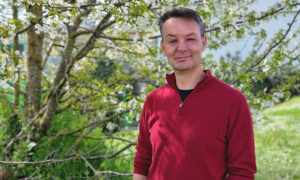
New directions for molecular systems biology at EMBL
Julia Mahamid and Nassos Typas reflect on the direction of the Molecular Systems Biology Unit they now lead at EMBL Heidelberg

In 2022, EMBL introduced its latest five-year research programme, Molecules to Ecosystems, launching a new era to look more at ‘life in context’. It built on solid foundations of decades-long pioneering molecular biology work, expanding the prism to view molecular biology in its environmental and ecological contexts. It now also includes a renamed research unit.
The new Molecular Systems Biology (MSB) Unit will study how single cellular components (proteins, RNA, metabolites, lipids) come together to build pathways, complexes and machines. Scientists here are interested in both how such specific cellular functions arise and how these individual cellular functions coordinate to give rise to cells and organisms that can interact with and adapt to their environment. Building on the vision of EMBL’s original Structural and Computational Biology Unit, the MSB Unit’s vision reflects the increasing capabilities nowadays to look comprehensively at systems rather than just at individual parts in isolation. EMBL Senior Scientists Julia Mahamid and Nassos Typas will lead the unit.
Christoph Müller has successfully led the Structural and Computational Biology Unit for 17 years and will step down as a unit head, while still maintaining his leadership role as Deputy Head of the EMBL Imaging Centre and Senior Scientist. Together with Peer Bork, Müller started and initially co-led the unit with the vision to build a creative, supportive and integrative research environment where structural and computational biologists would work together under one roof. This led to transformational research and impactful achievements over the years.
Here, Mahamid (JM) and Typas (NT) share their thoughts on the unit’s future – its research, direction, and opportunities.
What is molecular systems biology, and why is EMBL focusing more on it?
NT: Until recently, if scientists wanted to systematically assess gene function in an organism, they would use large-scale genetic screens and quantitative genome-wide data to link genes to other genes, or genes to cellular phenotypes.
JM: Structural predictions, however, changed the game. Nowadays one can assess gene/protein function and interactions at a genome-wide level using such methods. At the same time, breakthroughs in experimental structural biology methods, including in cryo-electron tomography (cryo-ET), allow us to see functional units in action in a living cell.
And as always, to really understand how protein machines work, scientists need in vitro approaches, too. Biochemistry, structural biology, and biophysics are vital for this.
NT: In our opinion, this unit is uniquely able to offer strong multidisciplinary expertise and approaches in all these areas to look systematically into molecular functions and machines at a whole cell level. This is what we call molecular systems biology – bridging systems biology to molecular mechanisms in the cellular context.
Where has EMBL already applied systems biology approaches?
JM: EMBL scientists are very strong in establishing collaborative approaches within and outside of the organisation. In the MSB Unit, we anticipate a strong synergy between experimental and computational groups that will allow us to push even further the integration of complex heterogeneous data across scales.
For example, many of the unit’s research groups are interested in dissecting the principles of the assembly and functions of biomolecular condensates, such as those that build up the nucleolus where ribosomal RNA transcription and assembly happen. This requires integrating spatiotemporal analyses of the underlying cellular processes across scales and developing and combining methods for correlative microscopies, cryo-ET, machine learning for data mining and analysis, and proteomics. At the same time, detailed structural analysis and in vitro reconstituted systems improve our understanding of the function and molecular dynamics of these systems, and feedback to the insights we get from in situ approaches.
NT: Interaction between microbes and their communities is another prime area that exemplifies convergent interests in the unit. Here, a number of groups both within and outside the unit have joined forces as part of the Microbial Ecosystems Transversal Theme to generate the functional knowledge and tools required to establish new model species for the human gut microbiome. Approaches ranging from high-throughput genetics and multi-omics to in situ structural biology are combined to systematically map protein function and organisation in two gut bacterial species, which are key and abundant members of the microbial communities present in everybody’s gut.
What is your vision for the new unit?
JM: Across the MSB Unit, we aim to gain quantitative and mechanistic insights into molecular machines, pathways, and cellular functional units. Functional units are the minimal macromolecular structures that can perform a cellular function. We study how macromolecules work together to form functional units and how these units are coordinated inside the cell. What is really special is that we are doing this across different scales – evolutionary, temporal and spatial – as well as in changing environments, such as those any living organism encounters in its physical environment.
NT: We envisage that the MSB Unit will pioneer technologies and large-scale data integration to study biological processes at the level of cells, organisms, communities, and ecosystems. The unit’s groups and teams are at the forefront of developing technologies that allow us to integrate research in many different areas. These include the systematic quantification of protein levels and states; mapping and predicting protein and RNA structures, evolution, dynamics and interactions; observing and studying macromolecular organisation and complexes in situ; and mapping how changes in macromolecules affect function. We want to build on this expertise to create holistic perspectives of protein/RNA networks and a quantitative understanding of dynamic macromolecular systems.
You two have quite different research foci. How does your work integrate and how will you work together as joint heads?
JM: Although the technologies we use are distinct, we are both driven by similar questions and use complementary approaches to answer them. To give you an example, my lab pioneers technologies to enable high-resolution structural biology in single cells, tissues, and organisms. These approaches have enabled us recently to gain 3D high-resolution reconstructions of the ribosome bound to the antibiotic chloramphenicol inside a pathogenic bacterium. This helps us understand better the complex effect of this antibiotic’s mode of action in the cell. Nassos’s group has measured thousands of interactions between antibiotics across many different bacterial species, which allowed them to chart the general principles behind their mode of interaction. Even though drugs have the same cellular targets in different species, they interact differently, because the interactions depend on the path the drug uses to come in and out of the cell, rather than on the process they target. This knowledge has opened the door to the use of drug combinations to find new solutions against pathogens or to mitigate the collateral damage from antibiotics to commensal bacteria.
So despite the different approaches, the common basis is an effort to bridge systems to molecular mechanisms. As approaches are complementary, combining them to address the same problem (here antibiotic mode of action and interaction) can be very powerful.
NT: Besides common interests in biology, we also share a vision on how to tackle biological questions: combining systematic and quantitative approaches with tailored molecular approaches and working with others. The latter is not unique to the two of us. The entire unit – and EMBL as a whole – share this mindset. So we feel our role here is simple. We get to lead and work together with a group of people who share similar principles and scientific curiosity.
In terms of logistics, the two of us will rotate the managing role as the Head of Unit every two years, with me starting. Julia will take over in 2026, and we continue on in that fashion. The managing head will represent the unit in official meetings, but we will both be available to the unit at any time and able to make decisions together.
How will the work of this new unit carry on work done in the former Structural and Computational Biology Unit?
JM: The unit is a physical continuation of what Christoph Müller and Peer Bork fostered for more than 15 years. We now build upon their vision to bring structural and computational biologists under the same roof and look into cellular functions at different levels of granularity. With structural biology becoming a more integrated discipline, and bioinformatics enabling highly accurate structural predictions, the link between the two halves of the SCB Unit is more timely than ever. With Nassos and Misha Savitski joining the unit, but also several other recent SCB hires, we have the opportunity to combine systematic perturbations and quantitative global measurements into the mix. Within the unit, we can look at the full cycle: perturbation to quantitative results and structural insights of the cellular state, complemented by computational modelling.
NT: This is why we wanted a unit name that exemplifies this iterative approach and interdisciplinarity. Molecular Systems Biology reflects this broad swath of quantitative technologies we use, and that can be integrated to answer different biological questions at a systematic level.


